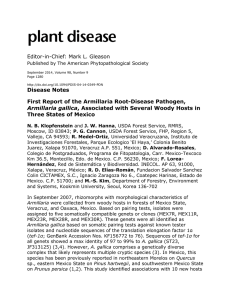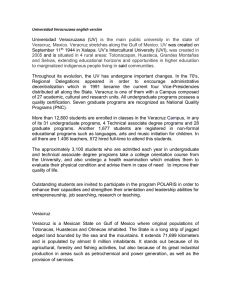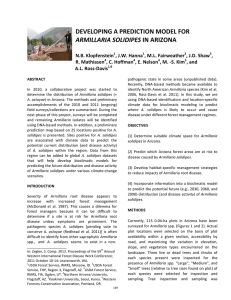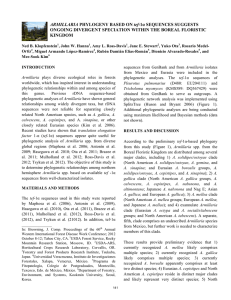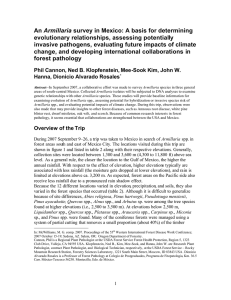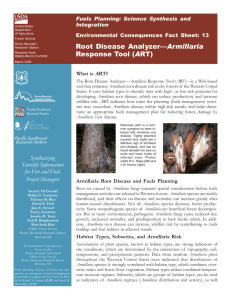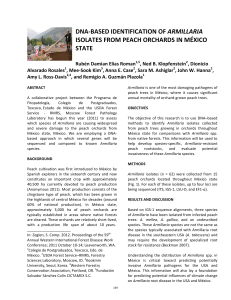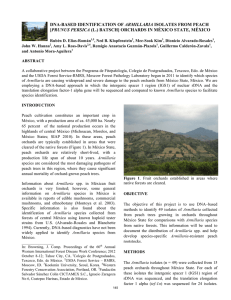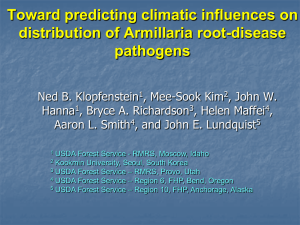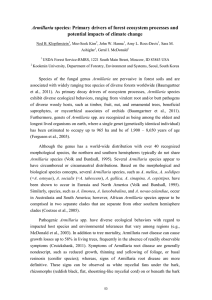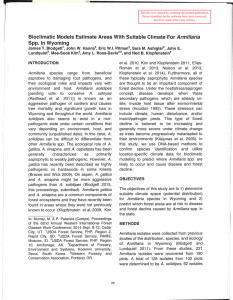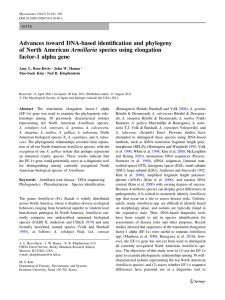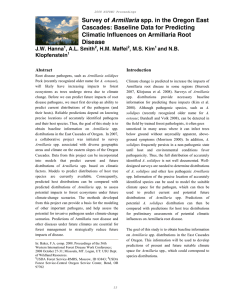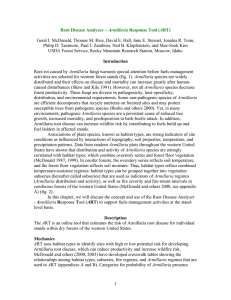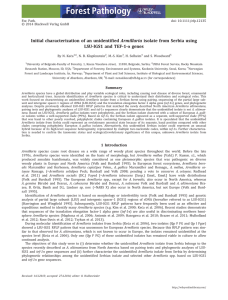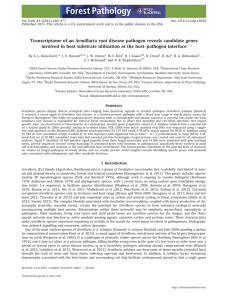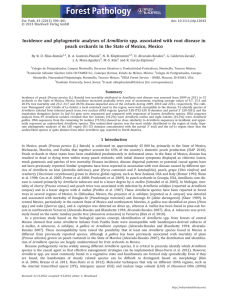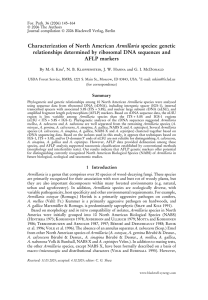Document 11790653
advertisement
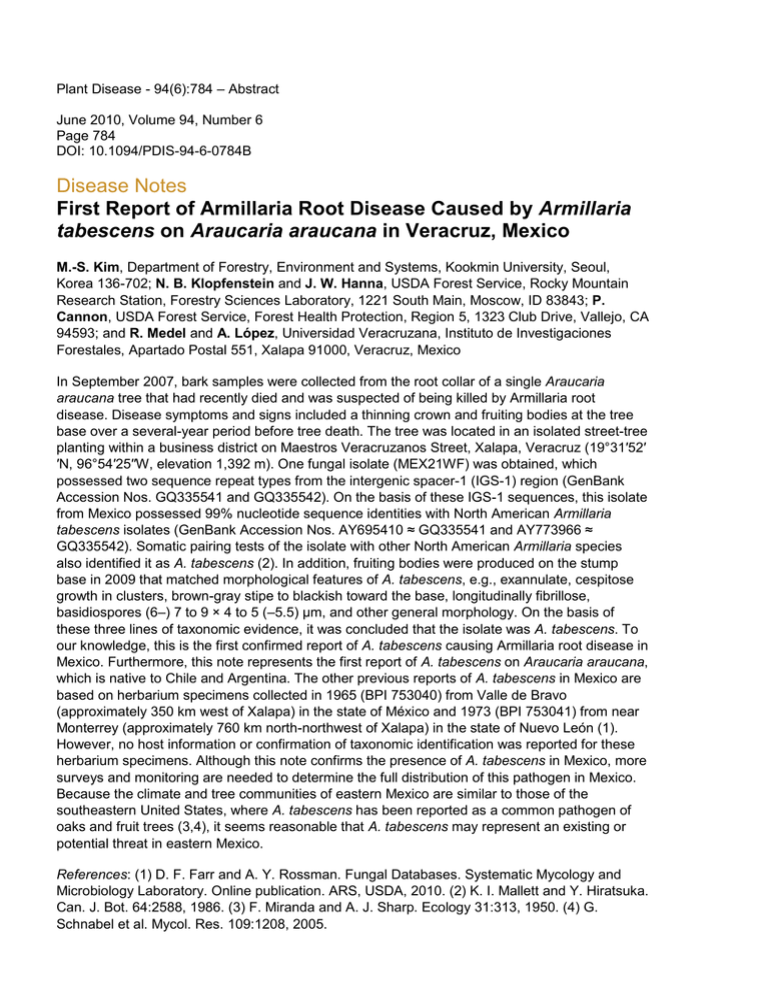
Plant Disease - 94(6):784 – Abstract June 2010, Volume 94, Number 6 Page 784 DOI: 10.1094/PDIS-94-6-0784B Disease Notes First Report of Armillaria Root Disease Caused by Armillaria tabescens on Araucaria araucana in Veracruz, Mexico M.-S. Kim, Department of Forestry, Environment and Systems, Kookmin University, Seoul, Korea 136-702; N. B. Klopfenstein and J. W. Hanna, USDA Forest Service, Rocky Mountain Research Station, Forestry Sciences Laboratory, 1221 South Main, Moscow, ID 83843; P. Cannon, USDA Forest Service, Forest Health Protection, Region 5, 1323 Club Drive, Vallejo, CA 94593; and R. Medel and A. López, Universidad Veracruzana, Instituto de Investigaciones Forestales, Apartado Postal 551, Xalapa 91000, Veracruz, Mexico In September 2007, bark samples were collected from the root collar of a single Araucaria araucana tree that had recently died and was suspected of being killed by Armillaria root disease. Disease symptoms and signs included a thinning crown and fruiting bodies at the tree base over a several-year period before tree death. The tree was located in an isolated street-tree planting within a business district on Maestros Veracruzanos Street, Xalapa, Veracruz (19°31′52′ ′N, 96°54′25′′W, elevation 1,392 m). One fungal isolate (MEX21WF) was obtained, which possessed two sequence repeat types from the intergenic spacer-1 (IGS-1) region (GenBank Accession Nos. GQ335541 and GQ335542). On the basis of these IGS-1 sequences, this isolate from Mexico possessed 99% nucleotide sequence identities with North American Armillaria tabescens isolates (GenBank Accession Nos. AY695410 ≈ GQ335541 and AY773966 ≈ GQ335542). Somatic pairing tests of the isolate with other North American Armillaria species also identified it as A. tabescens (2). In addition, fruiting bodies were produced on the stump base in 2009 that matched morphological features of A. tabescens, e.g., exannulate, cespitose growth in clusters, brown-gray stipe to blackish toward the base, longitudinally fibrillose, basidiospores (6–) 7 to 9 × 4 to 5 (–5.5) μm, and other general morphology. On the basis of these three lines of taxonomic evidence, it was concluded that the isolate was A. tabescens. To our knowledge, this is the first confirmed report of A. tabescens causing Armillaria root disease in Mexico. Furthermore, this note represents the first report of A. tabescens on Araucaria araucana, which is native to Chile and Argentina. The other previous reports of A. tabescens in Mexico are based on herbarium specimens collected in 1965 (BPI 753040) from Valle de Bravo (approximately 350 km west of Xalapa) in the state of México and 1973 (BPI 753041) from near Monterrey (approximately 760 km north-northwest of Xalapa) in the state of Nuevo León (1). However, no host information or confirmation of taxonomic identification was reported for these herbarium specimens. Although this note confirms the presence of A. tabescens in Mexico, more surveys and monitoring are needed to determine the full distribution of this pathogen in Mexico. Because the climate and tree communities of eastern Mexico are similar to those of the southeastern United States, where A. tabescens has been reported as a common pathogen of oaks and fruit trees (3,4), it seems reasonable that A. tabescens may represent an existing or potential threat in eastern Mexico. References: (1) D. F. Farr and A. Y. Rossman. Fungal Databases. Systematic Mycology and Microbiology Laboratory. Online publication. ARS, USDA, 2010. (2) K. I. Mallett and Y. Hiratsuka. Can. J. Bot. 64:2588, 1986. (3) F. Miranda and A. J. Sharp. Ecology 31:313, 1950. (4) G. Schnabel et al. Mycol. Res. 109:1208, 2005.


